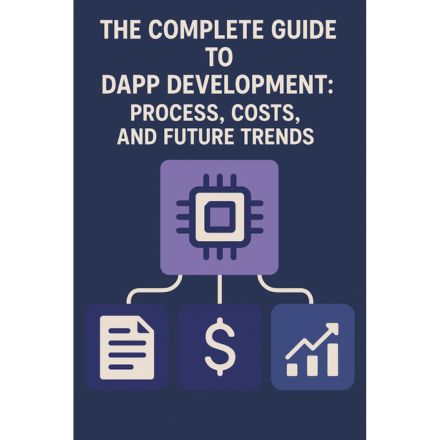
In a world rapidly embracing decentralization, decentralized applications (DApps) are becoming the backbone of the next generation of internet technologies. Whether it’s finance, gaming, healthcare, or social media, DApps offer unparalleled transparency, security, and autonomy. If you’re looking to understand how to create one, this DApp development guide will walk you through the development process, discuss the DApp development cost, and explore what the future holds for decentralized applications.
What is a DApp?
Before diving into the process, let’s briefly define what a DApp is. A decentralized application runs on a blockchain network instead of centralized servers. It utilizes smart contracts — self-executing code — to automate operations and remove intermediaries. Ethereum, Binance Smart Chain, and Polygon are some of the most popular blockchains for DApp development today.
Unlike traditional applications, DApps offer open-source code, token-based incentives, and user control over data. They are censorship-resistant, highly secure, and community-driven — attributes that are reshaping industries across the globe.
Step-by-Step DApp Development Guide
Creating a successful DApp involves several structured phases. Here’s a breakdown:
1. Ideation and Planning
The first step in this DApp development guide is clarifying the app’s purpose and identifying the problem it solves. Consider:
-
What industry or sector will it serve (finance, gaming, healthcare, etc.)?
-
What features will make it truly decentralized?
-
What blockchain platform will you use?
Creating a comprehensive whitepaper or business plan at this stage is essential for clear direction.
2. Choose the Right Blockchain
Ethereum remains the most popular platform for DApps, but alternatives like Solana, Avalanche, and Binance Smart Chain offer lower fees and faster transactions. Your choice will affect scalability, user experience, and overall DApp development cost.
3. Smart Contract Development
Smart contracts are the core of DApps. Writing these contracts in programming languages like Solidity (for Ethereum) or Rust (for Solana) requires expertise. Key aspects include:
-
Defining contract functionality
-
Ensuring security measures against common vulnerabilities
-
Extensive testing before deployment
4. Frontend and Backend Development
The frontend (user interface) should feel intuitive and accessible, much like any traditional web app. However, the backend logic should interact seamlessly with the blockchain via libraries like Web3.js or Ethers.js.
Important considerations:
-
Wallet integration (e.g., MetaMask, WalletConnect)
-
Smooth communication between smart contracts and the UI
-
Minimal reliance on centralized servers to maintain decentralization
5. Testing and Audit
Due to the immutable nature of blockchain, testing is critical. Once a smart contract is deployed, it cannot be easily altered. Comprehensive testing includes:
-
Unit testing
-
Integration testing
-
Security audits by reputable firms
Security breaches can cause irreversible damage, so this step cannot be overlooked.
6. Deployment and Maintenance
After successful testing, deploy your DApp on the mainnet. However, development doesn’t end here. Ongoing maintenance includes:
-
Updating the UI/UX
-
Upgrading functionalities through proxy contracts
-
Monitoring for emerging vulnerabilities
What is the DApp Development Cost?
One of the biggest concerns for businesses and entrepreneurs is the DApp development cost. While it varies greatly depending on the project’s complexity, here’s a general breakdown:
Thus, the initial DApp development cost can range from $40,000 to $100,000 or more for complex applications, not including marketing, user acquisition, and scaling infrastructure.
Factors influencing the cost include:
-
Blockchain platform chosen
-
Complexity of smart contracts
-
Number of features (wallet integration, NFT functionality, DeFi modules, etc.)
-
Team experience and geographic location
Opting for a skilled development team with expertise in smart contracts and blockchain frameworks can ensure a higher return on investment despite the upfront costs.
Future Trends in DApp Development
The future of DApps looks incredibly promising, fueled by rapid technological advancements and growing public interest. Here are some emerging trends to watch:
1. Multi-Chain and Cross-Chain Interoperability
DApps are moving toward interoperability, allowing users to operate seamlessly across multiple blockchains. Bridges and protocols like Polkadot and Cosmos are pioneering this change.
2. Layer-2 Scaling Solutions
With Ethereum’s congestion issues, Layer-2 solutions like Optimistic Rollups and zk-Rollups are gaining traction, offering faster and cheaper transactions without compromising security.
3. Integration with AI and IoT
Expect DApps to incorporate AI for smarter decision-making and IoT for decentralized device management. This will open new possibilities in smart cities, healthcare, and supply chain management.
4. Decentralized Identity (DID)
DApps will increasingly incorporate decentralized identity solutions, giving users complete control over their digital identities without relying on centralized authorities.
5. Focus on User Experience
To drive mass adoption, future DApps will prioritize simple onboarding, elegant UI designs, and user-friendly wallets. Reducing the learning curve will be key to reaching mainstream audiences.
Conclusion
This DApp development guide demonstrates that while creating a decentralized application is a complex and resource-intensive endeavor, the potential rewards are immense. From understanding the development process to calculating the DApp development cost, strategic planning is essential to success.
With blockchain technology continuing to evolve and public demand for decentralization growing, now is the ideal time to invest in DApp innovation. Whether you’re an entrepreneur, investor, or developer, embracing this new wave could place you at the forefront of the next digital revolution.